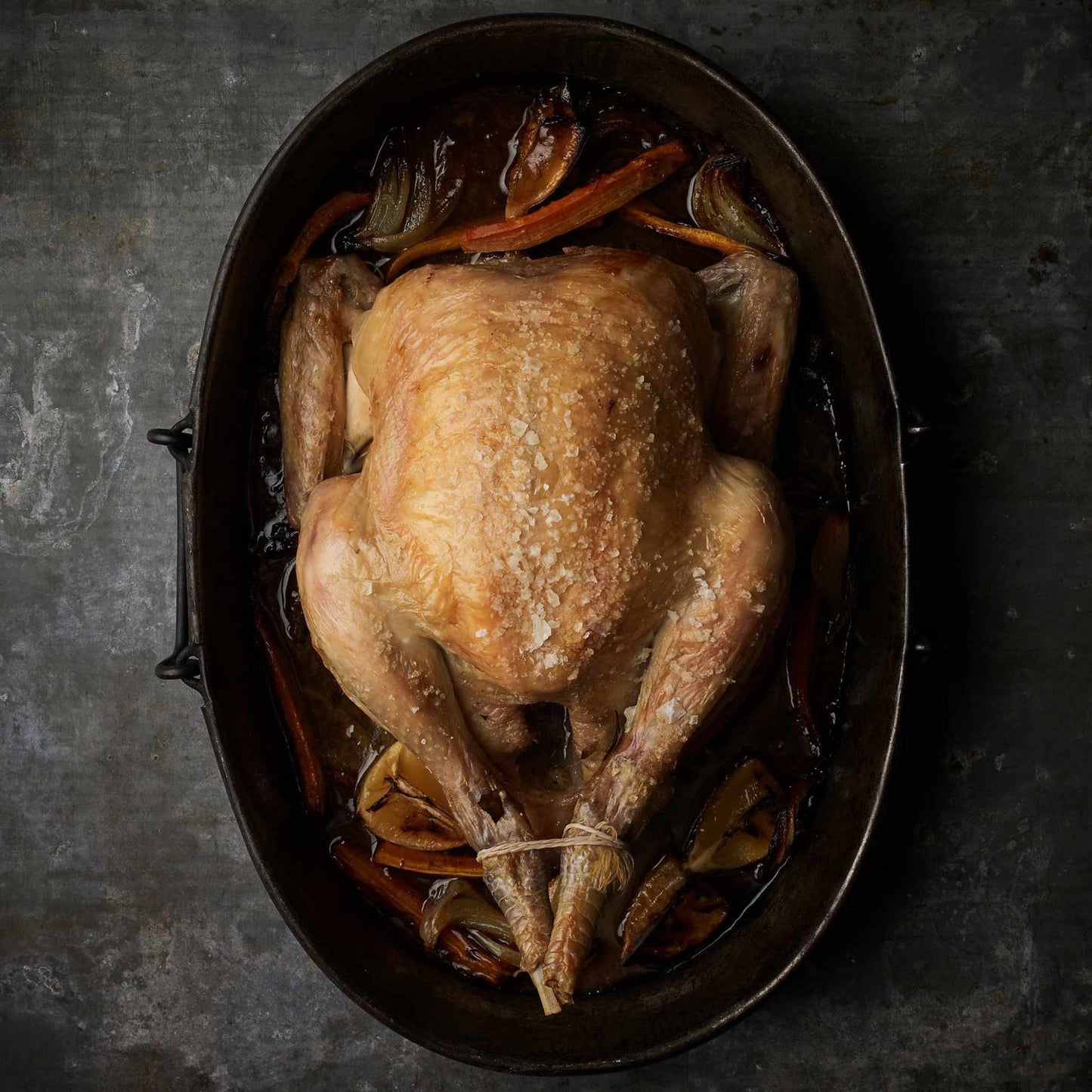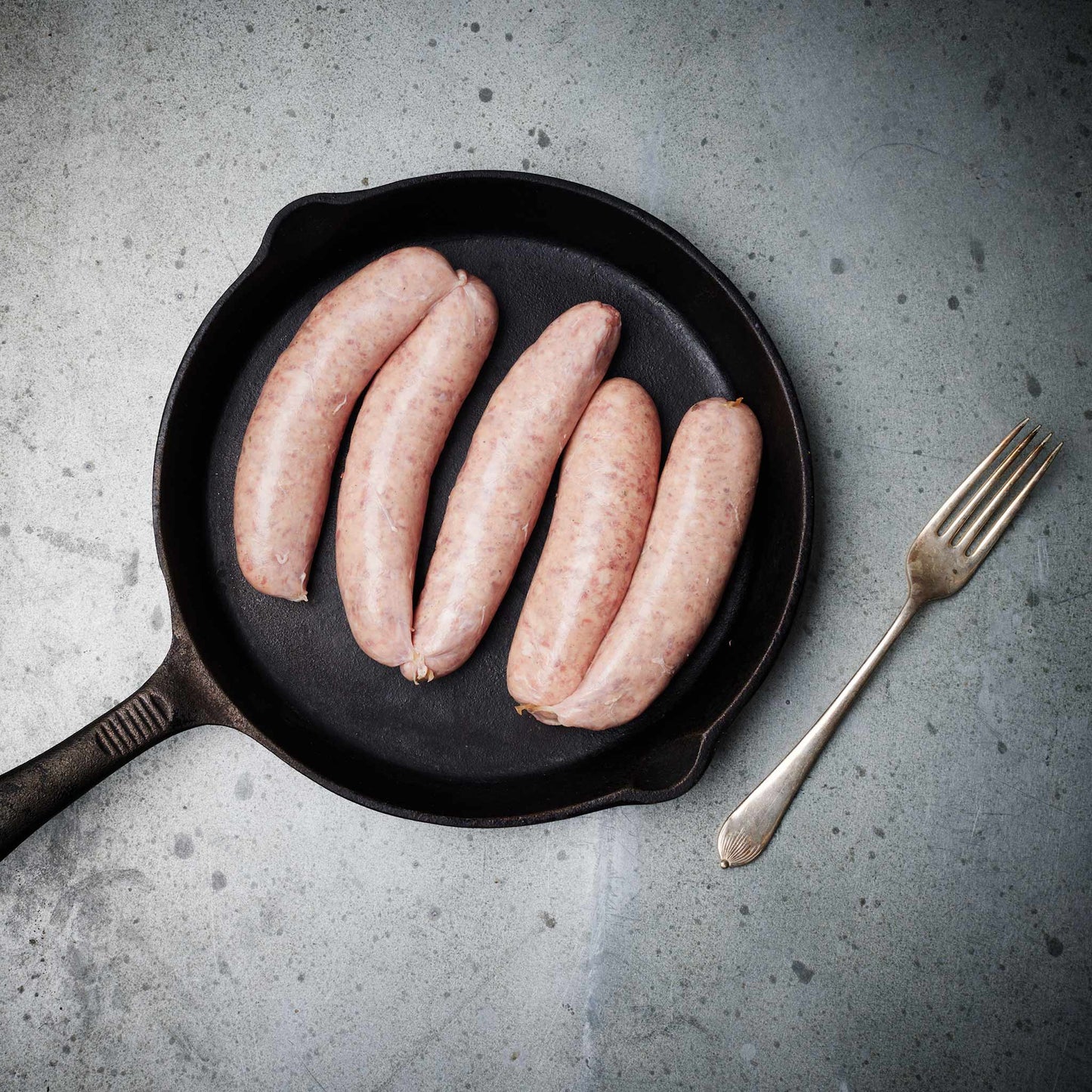We source our chicken from one farm in Leicestershire. The farm is Pasture for Life certified and rears truly free range, outdoor birds.

Why do we have turkey at Christmas?
From Wikipedia:
The turkey is a large bird in the genus Meleagris, native to North America. There are two extant turkey species: the wild turkey (Meleagris gallopavo) of eastern and central North America and the ocellated turkey (Meleagris ocellata) of the Yucatán Peninsula in Mexico. Males of both turkey species have a distinctive fleshy wattle, called a snood, that hangs from the top of the beak. They are among the largest birds in their ranges. As with many large ground-feeding birds (order Galliformes), the male is bigger and much more colorful than the female.
Although native to North America, the turkey probably got its name from the domesticated variety being imported to Britain in ships coming from the Levant via Spain. The British at the time therefore associated the bird with the country Turkey and the name prevailed. An alternative theory posits that another bird, a guinea fowl native to Madagascar introduced to England by Turkish merchants, was the original source, and that the term was then transferred to the New World bird by English colonizers with knowledge of the previous species.
The earliest turkeys evolved in North America over 20 million years ago. They share a recent common ancestor with grouse, pheasants, and other fowl. The wild turkey species is the ancestor of the domestic turkey, which was domesticated approximately 2,000 years ago.
How did this non-native bird become the centrepiece of our celebration meal?
The tradition dates back to King Henry VIII who decided to make it a tradition as the new world aka, the Americas was being 'discovered'. Turkeys were first brought into Britain in 1526; before this time, for Christmas meals, people used to eat geese, boars’ heads, and even peacock, the turkey offered an alternative to chickens which provided eggs and cows which provided milk.
Now the UK consumes a staggering 11 million turkeys each Christmas and the vast majority of these will not have seen much of the outdoors.
In the UK Turkeys are raised in 3 main ways:
Indoor
Most turkeys in the UK are reared in standard indoor production systems. This is where they live on the floor of large, purpose-built sheds or converted farm buildings. Up to 25,000 birds may be housed in one building.
In these conditions, the turkeys are often unable to carry out their normal behaviour, such as perching and foraging. However, some indoor systems may give them more space, more environmental enrichment and natural daylight through windows. It is worth noting that this method is responsible for by far the majority of the 11 million birds consumed.
Pole-barn
In 'pole-barns' the upper part of the house walls are open, allowing in natural light and air. However, the birds are still often unable to express their natural behaviours.
Free-range and organic turkeys
In free-range and organic systems, the housing may be similar to indoor or pole-barn systems, but the turkeys also have access to an outdoor range area.
Our version - Outdoor reared
Our turkeys are outdoor reared meaning simply that they live outdoors but are offered an indoor perch at night. During daylight hours they are free to walk, peck, scratch and flap, exhibiting natural behaviors and of course, interacting with the land they are on deriving much of their nutrients from plants, seeds, roots and bugs, scratching and fertilising the land. This method of raising turkeys is unfortunately the most susceptible to bird flu.
So what's happening this year with bird flu?
First of all, what is bird flu?
Bird flu is pretty much what it sounds like, an influenza virus that affects birds. What is of concern at the moment we're talking about a particularly highly pathogenic avian influenza (HPAI) A(H5N1) which is highly contagious among birds, and can be deadly, especially in domestic poultry. This virus is a “reassortant” virus with genes from Asian HPAI H5 viruses and low pathogenic North American viruses. Reassortment occurs when the genes from two different viruses mix to create a new virus, this process is entirely natural and is an evolutionary mechanism.
What does it do to birds?
There have been 82 confirmed cases of highly pathogenic avian influenza (HPAI) H5N1 in England since 1 October 2022. There have been 216 cases of HPAI H5N1 in England since the H5N1 outbreak started on 27 October 2021.
In birds this virus is devastating with an overall case–fatality ratio (CFR) of around 50% making it as deadly to birds as anthrax is to us, in other words, not good.
Typically this form of the disease presents suddenly in laying chickens, often with very high mortality, with affected birds developing swollen heads, a blue colouration of the comb and wattles, dullness, lack of appetite, respiratory distress, diarrhoea and significant drop in egg production.
From RSPB:
The bird flu virus has had catastrophic effects on the UK’s breeding seabirds this summer, causing thousands of deaths and affecting the whole coast of the UK. Particularly badly affected were gannets, great skuas and terns. Overall, over sixty species of birds have tested positive, including six species of raptor.
How does it spread?
Infected birds shed bird flu virus through their saliva, mucus and feces making it very easy to spread since birds tend to, well, fly, this is especially true of waterfowl who can contaminate waterways further spreading the virus.
Bird flu is nothing new but this year the effects have been truly devastating for british farmers as we experience the worst outbreak ever seen.
ROBERT HARDMAN FOR THE DAILY MAIL
PUBLISHED: 22:28, 31 October 2022 | UPDATED: 08:53, 1 November 2022
Make no mistake, the avian flu epidemic is worse than anything anyone can recall. Whitehall officials, never ones for hyperbole, say it exceeds last winter's outbreak — and that was called 'the largest ever'.
At the start of October, the total number of cases among captive flocks had reached 161 — up from 26 in 2020-21.
Yet, since then, that number has rocketed by another 87, the latest being a farm in Lancashire which was wiped out last night.
It means that more than 5.5 million farmed turkeys, geese and ducks have died or been culled in the past year —2.3 million of them in the past month alone.
Yesterday, the Government announced a Covid-style lockdown on all kept birds across England. Under a new 'national housing order', all must remain indoors while new biosecurity measures must be in place for visitors.
The measures have come too late for an estimated 35 per cent of Britain's free-range poultry market which has already been culled.
This is on a par with the ghastly foot-and-mouth plague of 2001 in terms of the impact on a particular section of Britain's farming economy.
However, the whole nation knew all about foot-and-mouth because it hit cattle and sheep, which are a much more visible part of our public landscape.
This is a heartrending saga unfolding on poultry farms all over the country — right now.

This is a heartrending saga unfolding on poultry farms all over the country — right now. Pictured: Dead geese at Steve Childerhouse's Norfolk farm
The UK's 12 million-strong bovine population, plus 33 million sheep, occupy nearly 60 per cent of what's known as the country's 'utilised agricultural area'.
Poultry farming is a more sheltered business, with hundreds of millions of animals occupying a fraction of that space, often under cover and out of public view.
Yet all this contributes £6 billion to the national economy in terms of meat and eggs. One part of it is also almost entirely seasonal.
And this crisis raises the very real prospect of a dire shortage of both turkey and geese this Christmas. Only then, perhaps, will the rest of us actually wake up to the severity of what is going on.
A few weeks ago, Britain's biggest producer of Christmas geese, Suffolk's Gressingham Foods, lost its entire flock to avian flu. 'It's a race against time. Nearly all the geese are gone and a lot of the country's fresh turkey flock has already been lost,' says Paul Kelly.
What is The Ethical Butcher's stance on this year's tragic situation?
We do not support intensive indoor rearing of any animals and unfortunately this disease affects outdoor reared birds much more easily than indoor ones.
For the last few Christmases we've sold many hundreds of incredibly well raised outdoor reared turkeys but this year we stopped the pre orders very quickly as the situation unfolded.
We have ensured the supply of a very limited number of birds that are raised to standards we approve of but have capped this at a fraction of our usual volume to ensure we can honour these orders.
We urge our customers to think beyond turkey this year and to not support factory farming but to instead consider regeneratively farmed beef or lamb as a table centrepiece.
UPDATE: Ben Hill for The Sun Newspaper
7 Nov 2022, 01:18 | Updated: 7 Nov 2022, 01:18
The national housing measures, which were announced last week and are being introduced from Monday, are aimed at preventing house birds from interacting with wild birds.
It comes as the UK has been facing its largest outbreak of bird flu with more than 200 cases confirmed on commercial premises, smallholdings and in pet birds since October last year.
The Government said everyone must keep their birds inside regardless of the type of bird or numbers kept.
They are also being urged to follow other biosecurity measures mandated by the Avian Influenza Prevention Zone (AIPZ) at all times to protect their flock and prevent the risk of future outbreaks.
These include cleansing and disinfecting footwear and clothing before and after contact with birds, reducing the movement of people on to premises and storing bedding properly so it does not get contaminated by wild birds.
The Government has warned owners that avian influenza could kill house birds if action is not taken.
The new measures are being introduced after the disease was confirmed at over 90 premises and has been found in more than 200 dead wild birds since the start of October.
Christine Middlemiss, chief veterinary officer, said: “Many poultry keepers in England have excellent biosecurity standards but we know that one small mistake is all it takes to introduce bird flu on to premises and kill flocks.
“A housing order alone will not be enough to reduce infection rates. Implementing scrupulous biosecurity and separating flocks from wild birds remains the best form of defence.
“Whether you keep just a few birds or thousands, from today onwards they must be housed under cover to protect them from this highly infectious disease.”
The UK Health Security Agency continues to advise that the risk to public health from the virus is very low.
The Food Standards Agency advice that avian influenzas pose a very low food safety risk for UK consumers also remains unchanged.
Please note: Because of the above there will be no truly free range birds available this christmas



